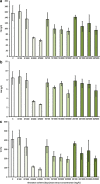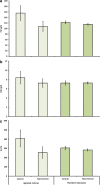Improved production of dibenzocyclooctadiene lignans in the elicited microshoot cultures of Schisandra chinensis (Chinese magnolia vine)
- PMID: 29181570
- PMCID: PMC5756551
- DOI: 10.1007/s00253-017-8640-7
Improved production of dibenzocyclooctadiene lignans in the elicited microshoot cultures of Schisandra chinensis (Chinese magnolia vine)
Abstract
Dibenzocyclooctadiene lignans are a specific group of secondary metabolites that occur solely in Schisandra chinensis. The aim of the presented work was to boost the accumulation of lignans in the agitated microshoot cultures of S. chinensis, using different elicitation schemes. The experiments included testing of various concentrations and supplementation times of cadmium chloride (CdCl2), chitosan (Ch), yeast extract (YeE), methyl jasmonate (MeJa), and permeabilizing agent-dimethylsulfoxide (DMSO). After 30 days, the microshoots were harvested and evaluated for growth parameters and lignan content by LC-DAD method. The analyses showed enhanced production of lignans in the elicited S. chinensis microshoots, whereas the respective media samples contained only trace amounts of the examined compounds (< 5 mg/l). Elicitation with CdCl2 caused up to 2-fold increase in the total lignan content (max. ca. 730 mg/100 g DW after the addition of 1000 μM CdCl2 on the tenth day). Experiments with chitosan resulted in up to 1.35-fold increase in lignan concentration (max. ca. 500 mg/100 g DW) after the supplementation with 50 mg/l on the first day and 200 mg/l on the tenth day. High improvement of lignan production was also recorded after YeE elicitation. After the elicitation with 5000 mg/l of YeE on the first day of the growth period, and with 1000 and 3000 mg/l on the 20th day, the lignan production increased to the same degree-about 1.8-fold. The supplementation with 1000 mg/l YeE on the 20th day of the growth cycle was chosen as the optimal elicitation scheme, for the microshoot cultures maintained in Plantform temporary immersion system-the total content of the estimated lignans was equal to 831.6 mg/100 g DW.
Keywords: Abiotic elicitors; Biotic elicitors; Elicitation; In vitro cultures; Schisandra lignan production; Temporary-immersion bioreactor.
Conflict of interest statement
Conflict of interest
The authors declare that they have no conflict of interest.
Ethical approval
This article does not contain any studies with human participants or animals performed by any of the authors
Figures





References
-
- Angelova Z, Georgiev S, Roos W. Elicitation of plants. Biotechnol Biotechnol Equip. 2006;20(2):72–83. doi: 10.1080/13102818.2006.10817345. - DOI
-
- Arroo RRJ, Alfermann AW, Medarde M, Petersen M, Pras N, Woolley JG. Plant cell factories as a source for anti-cancer lignans. Phytochem Rev. 2002;1(1):27–35. doi: 10.1023/A:1015824000904. - DOI
-
- Bahabadi ES, Sharifi M, Safaie N, Murata J, Yamagaki T, Satake H. Increased lignan biosynthesis in the suspension cultures of Linum album by fungal extracts. Plant Biotechnol Rep. 2011;5(4):367–373. doi: 10.1007/s11816-011-0190-3. - DOI
-
- Capote A. Increased cardenolides production by elicitation of Digitalis lanata shoots cultured in temporary immersion systems. Plant Cell Tissue Organ Cult. 2012;110(1):153–162. doi: 10.1007/s11240-012-0139-4. - DOI
MeSH terms
Substances
Grants and funding
LinkOut - more resources
Full Text Sources
Other Literature Sources

